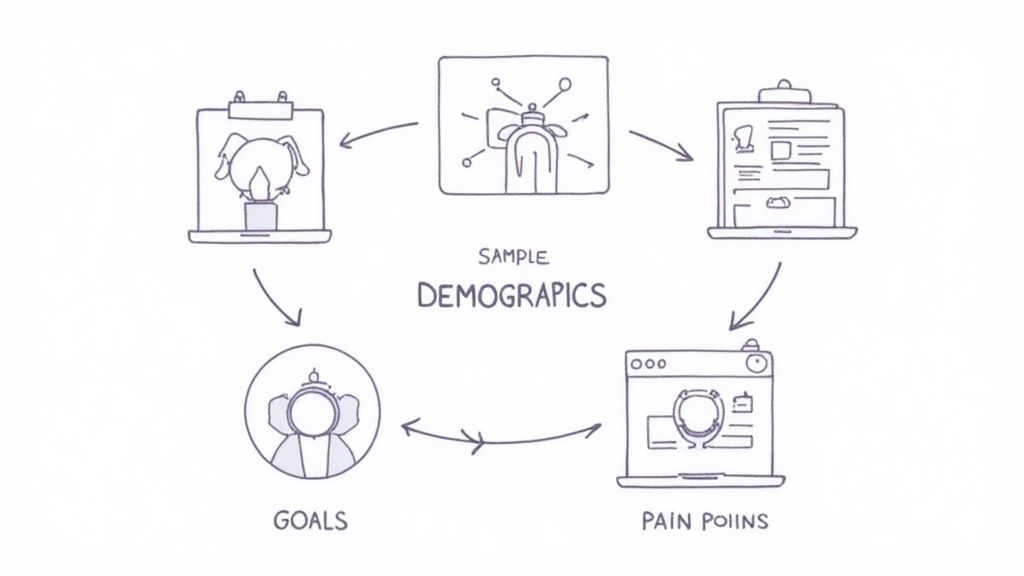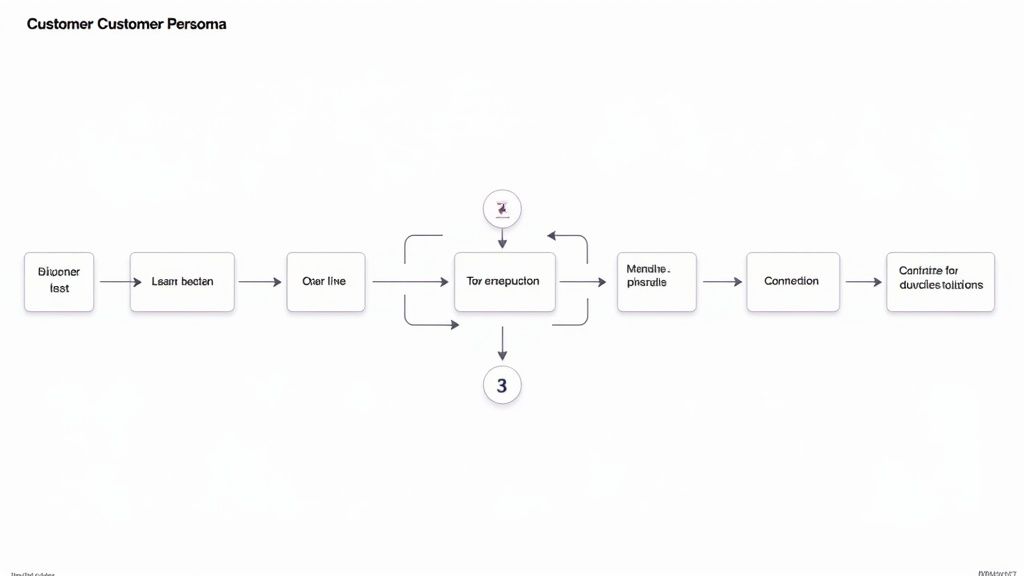Why Customer Personas Transform Your Marketing Results

Customer personas are the foundation of successful marketing. More than simple profiles, they provide a deep understanding of your ideal customers. They go beyond basic demographics to reveal motivations, pain points, and behaviors. This knowledge lets you tailor your marketing efforts, resonating with your audience personally and driving tangible results.
Consider marketing high-end athletic wear. Without a defined customer persona, messages might be too general, missing the mark with your ideal customer. However, a well-defined persona allows for targeted campaigns. These campaigns can address specific fitness goals, preferred workout styles, and even fashion preferences.
Creating customer personas is essential for businesses to understand and target their audiences. For example, demographic-based personas help companies tailor their products and services based on age, gender, and location. This significantly impacts marketing effectiveness. Imagine a business targeting males over 60 in the Midwest trying to sell women’s surfing gear. The mismatch is clear. This highlights the importance of demographic alignment in marketing strategies. Businesses using data-driven insights, like those gained from customer personas, tend to outperform those that don’t, improving customer satisfaction and retention.
How Personas Drive Measurable Improvements
The impact of customer personas is evident across key marketing metrics. By understanding your customers, you boost overall marketing performance. Here’s how:
- Increased Conversion Rates: Targeted messaging resonates, leading to higher conversion rates. When your message speaks directly to a customer’s needs, they are more likely to act.
- Improved Customer Satisfaction: Addressing specific pain points with tailored products and services creates satisfied, loyal customers.
- Enhanced Customer Retention: Understanding customer behaviors enables anticipating future needs. Proactively offering solutions builds stronger relationships and increases retention.
Moving From Assumptions to Data-Driven Strategies
Assumption-based marketing relies on guesswork and broad strokes, often leading to wasted resources and ineffective campaigns. Customer persona templates, however, enable a data-driven approach. This shift provides crucial insights to create highly targeted and effective marketing campaigns. The result? Greater return on investment and stronger customer connections. A successful customer persona template reveals not just who your customers are, but why they buy.
Core Elements That Make Customer Persona Templates Work
A well-crafted customer persona template goes beyond simple demographics. It’s a dynamic snapshot of your ideal customer, bringing to life their motivations, behaviors, and needs. This deeper understanding helps you connect with your audience in more meaningful ways and achieve stronger marketing results.
Beyond the Basics: Key Components of an Effective Template
While demographics like age, location, and occupation provide a basic foundation, truly effective customer personas delve deeper into the psychographic and behavioral aspects of your target audience. This means understanding their values, interests, lifestyle, and online habits. Knowing how to define and reach your target audience is crucial for creating accurate and actionable personas. You can learn more about this process in this article on how to identify your target audience.
Let’s explore some core components:
- Motivations: Understanding the why behind customer purchases is critical. What are their goals, aspirations, and pain points? What drives their purchasing decisions—price, quality, or social impact? This knowledge allows you to tailor your messaging and product development to directly address these motivations.
- Behaviors: How do your customers interact with your brand and your competitors? Where do they spend their time online? What type of content do they consume? Analyzing these behavioral patterns reveals key insights for channel selection, content strategy, and overall marketing optimization.
- Communication Preferences: How do your customers prefer to be contacted? Are they most responsive to email, social media, or direct mail? Understanding these preferences allows for personalized outreach that resonates and avoids alienating potential customers. Some might prefer short, concise messages, while others appreciate detailed, informative content.
To better understand how these components fit into a template, let’s examine the following table:
Understanding the strategic value of each component and how to collect data will ensure your personas are as effective as possible.
| Component | Description | Strategic Value | Data Collection Methods |
|---|---|---|---|
| Demographics | Basic background information such as age, location, occupation, income level, education, family status. | Provides a basic understanding of the customer profile, helping segment your audience and target your marketing efforts. | Surveys, market research reports, website analytics. |
| Psychographics | Values, interests, lifestyle, personality, attitudes, opinions. | Helps understand the customer’s motivations and what drives their decisions, allowing for more effective messaging. | Surveys, interviews, social media listening, focus groups. |
| Behaviors | Online behavior, purchase history, brand interactions, product usage. | Provides insights into customer actions and preferences, informing product development and marketing strategies. | Website analytics, customer relationship management (CRM) data, social media analytics. |
| Motivations | Goals, aspirations, pain points, needs, desires. | Understanding customer needs allows for tailored messaging and product development that directly address those needs. | Interviews, surveys, focus groups. |
| Communication Preferences | Preferred communication channels, content formats, tone of voice. | Enables personalized outreach that resonates with the customer and avoids alienation. | Surveys, A/B testing, customer feedback. |
This table outlines the essential elements of a comprehensive customer persona template and explains their importance for business strategy. By including these components, you create a well-rounded view of your ideal customer.
Validating Your Personas: Ensuring Accuracy and Relevance
Building a customer persona template is not a one-time task. It requires ongoing validation and refinement to ensure it accurately reflects real customer behavior. This involves gathering feedback through surveys, interviews, and website analytics data. Actively seeking customer input helps identify gaps and inaccuracies in your assumptions, leading to more effective marketing strategies.
Prioritizing Information: Adapting to Your Business Model
Not every element of a customer persona carries the same weight. The specific information you prioritize depends on your business model and objectives. For example, a B2B software company might prioritize a customer’s job title, company size, and industry, while an e-commerce retailer might focus on purchase history, browsing behavior, and product preferences. This targeted approach ensures your customer personas are relevant and actionable for your specific needs, leading to highly focused campaigns, personalized experiences, higher conversion rates, and improved customer satisfaction.
Building Your First Customer Persona Template: A Blueprint

Creating effective customer personas is essential for a successful marketing strategy. A well-defined template provides the foundation for capturing valuable insights about your target audience. This blueprint outlines the key steps to building a robust customer persona template.
Defining Your Objectives: Setting the Foundation
Before you start gathering data, it’s crucial to define your business objectives. Ask yourself what you aim to achieve with these personas. Are you focused on increasing website conversions? Perhaps your goal is to improve customer retention or launch a new product. Clear objectives ensure your customer persona template captures relevant information and remains aligned with your overall business goals.
Research and Data Collection: Gathering the Raw Materials
Once you have established your objectives, begin collecting data about your target audience. Several effective methods can provide valuable insights:
- Customer Interviews: One-on-one interviews offer in-depth qualitative data, revealing customer motivations and pain points.
- Surveys: Use surveys to collect quantitative data from a larger audience, providing insights into demographics and behavioral patterns. Tools like SurveyMonkey can streamline this process.
- Website Analytics: Analyze website data using tools like Google Analytics to understand customer behavior on your site, including page visits, time spent on pages, and conversion rates.
- Social Media Listening: Monitor social media platforms to understand customer sentiment towards your brand and competitors. Tools like Brand24 can help you track relevant conversations.
Combining qualitative and quantitative data paints a comprehensive picture of your target audience. This multifaceted approach ensures your customer personas are detailed and accurate.
Structuring Your Template: Organizing the Insights
A well-structured template is crucial for organizing the data you’ve collected. Categorize your findings into logical sections:
- Background: Include demographic information such as age, location, occupation, and family status.
- Goals and Motivations: What are their needs and aspirations? Understanding these drivers is key to crafting resonant marketing messages.
- Challenges and Pain Points: What problems are they trying to solve? Addressing these challenges directly positions your product or service as a solution.
- Behaviors: How do they interact with brands, including yours and your competitors? Understanding their online behavior, purchase history, and brand preferences informs your marketing approach.
- Communication Preferences: Which channels do they use? What type of content resonates with them? This information allows for personalized and effective outreach.
A structured template makes it easier to analyze data and draw meaningful conclusions. This organized approach helps you identify patterns and develop actionable insights about your target audience. Creating customer personas involves several steps, from user research and grouping similar users to assigning specific traits to these personas. HubSpot offers resources and examples to guide you through this process. They emphasize that these personas are semi-fictional representations based on real data and market research, creating a strategic model of your ideal customer.
Refining and Validating: Ensuring Accuracy
After building your initial template, refine it based on feedback and further analysis. Validate your personas against real customer data to ensure accuracy. This iterative process helps your customer persona template stay relevant and valuable over time, capturing evolving customer needs and market trends. Regular review and updates are essential for keeping your personas aligned with your marketing goals.
Putting Your Customer Persona Template Into Action

Creating a customer persona template is only the first step. The real value comes from integrating these personas into your daily operations. It’s about moving beyond simply possessing personas to actively utilizing them. This shift transforms theoretical profiles into dynamic tools that guide decisions and improve business outcomes.
Activating Your Personas: From Theory to Practice
Leading organizations leverage customer personas across multiple departments. This cross-functional approach ensures a consistent customer-centric strategy throughout the company. Marketing teams, for instance, use personas to develop resonant messaging. Meanwhile, product development teams utilize them to prioritize features that address real customer problems. This collaborative application creates a unified understanding of the target audience, leading to a more cohesive and effective overall strategy.
Practical Applications Across Departments
Let’s explore how different departments can use customer persona templates:
- Content Marketing: Develop targeted content that resonates with your audience’s interests and needs. This approach generates higher engagement, improved conversion rates, and stronger brand loyalty. For example, a persona might reveal a preference for video content, leading to a greater emphasis on video marketing efforts.
- Product Development: Understand your customers’ pain points to prioritize features that solve real problems. This leads to more user-friendly products and increased customer satisfaction.
- Sales Enablement: Provide your sales team with targeted pitches that address specific customer pain points and motivations. This results in more effective sales conversations and higher closing rates.
- Customer Experience Design: Create customer journey maps that anticipate your audience’s needs. This allows you to build seamless and personalized experiences that foster customer loyalty.
From Data to Human-Focused Profiles
Customer personas are powerful tools for understanding your audience. Companies like Canva offer customer persona templates to help businesses translate raw data into human-focused profiles. This allows organizations to understand their audience’s experiences and motivations. These insights then guide strategic product development, leading to more intuitive and user-friendly designs that meet the specific needs of the target audience. You can explore Canva’s user persona templates here.
Measuring Impact and Maintaining Consistency
Implementing customer personas effectively requires ongoing effort. This includes:
- Securing Buy-In: Ensure that all relevant departments understand the value of customer personas and are committed to their use. This creates a shared understanding of and commitment to customer-centricity.
- Measuring Impact: Track key metrics to evaluate the effectiveness of persona-driven initiatives. This allows for data-backed optimization and demonstrates the tangible value of persona implementation.
- Maintaining Consistency: Regularly review and update your customer personas. This ensures that your personas remain relevant and accurately reflect your evolving target audience, keeping strategies aligned with actual customer behavior and market trends. Regular reviews and updates are essential for ensuring your personas stay powerful tools for strategic decision-making.
Customer Persona Templates That Actually Drive Results

A customer persona template provides the framework for understanding your target audience. Simply using a generic template, however, isn’t enough. To truly drive results, you need to understand how effective templates are applied in real-world situations. This section explores concrete examples of customer persona templates that have improved marketing performance across diverse industries.
Real-World Examples of High-Impact Templates
Examining successful implementations helps to illustrate the power of well-crafted customer personas. Let’s explore a few examples:
- B2B Services: Imagine a marketing automation software company like HubSpot targeting marketing managers in mid-sized businesses. Their customer persona template would likely focus on pain points such as lead generation, campaign management, and reporting. This focus allows them to tailor their messaging and product demos to directly address these specific needs.
- E-commerce Retailers: An online clothing store might create personas based on shopping habits, style preferences, and price sensitivity. One persona could be a “budget-conscious fashionista” while another is a “luxury shopper.” This targeted approach allows for personalized product recommendations and promotions.
- SaaS Companies: A project management software company like Asana might develop personas for different user roles within a team, such as project managers, developers, and designers. This allows them to showcase the features most relevant to each user’s specific needs and workflow.
- Professional Service Firms: A law firm specializing in intellectual property might create personas for different client types, like startups, established businesses, and individual inventors. This allows them to tailor consultations and service offerings to the unique situation of each client.
These diverse examples showcase how adaptable customer persona templates can be across various business models. The key is to customize the template to reflect your specific market and target audience.
Industry-Specific Considerations
Different industries require tailored approaches to customer persona development. Here’s a closer look at some key considerations:
- Healthcare: Compliance concerns, emotional factors, and building trust play a significant role. Understanding patient needs and anxieties is paramount.
- Financial Services: Risk tolerance, investment goals, and the client decision-making process are key elements. Trust and security are also critical.
- Technology: Technical expertise, adoption barriers, and the desire for innovation influence persona development. Understanding user experience is crucial.
- Retail: Purchase frequency, brand loyalty, and other factors influencing purchasing decisions are key considerations. Understanding customer preferences and their shopping habits is essential.
To further illustrate these industry-specific nuances, consider the following table:
To help illustrate the varying approaches, let’s look at a comparison table:
Industry-Specific Customer Persona Considerations
| Industry | Key Persona Elements | Unique Considerations | Common Pitfalls |
|---|---|---|---|
| Healthcare | Demographics, Health Conditions, Lifestyle, Information Sources | Patient Privacy (HIPAA), Emotional Needs, Trust in Providers | Overlooking emotional factors, neglecting accessibility needs. |
| Financial Services | Income, Investment Goals, Risk Tolerance, Financial Knowledge | Regulatory Compliance, Security Concerns, Long-Term Relationships | Focusing solely on demographics, neglecting client communication preferences. |
| Technology | Tech Proficiency, Devices Used, Online Behavior, Pain Points | Rate of Tech Adoption, User Experience, Security Needs | Assuming a high level of technical expertise, neglecting user testing. |
| Retail | Shopping Habits, Brand Loyalty, Price Sensitivity, Preferred Channels | Omnichannel Experience, Influencer Marketing, Personalization | Overlooking customer segmentation, neglecting in-store experience. |
This table highlights how diverse industries require specific approaches to persona development, emphasizing different elements and potential pitfalls.
From Insights to Action: Measuring the Impact of Personas
The ultimate goal of any customer persona template is to achieve measurable results. This means tracking key performance indicators (KPIs) such as website conversions, lead generation, sales growth, and customer satisfaction. By analyzing these metrics, you can determine the effectiveness of your persona-driven strategies and make data-backed adjustments. This continuous optimization ensures your customer personas remain a powerful tool for business growth.
Evolving Your Customer Persona Templates Over Time
Customer persona templates aren’t static documents. Just like the customers they represent, they must adapt and evolve. This ongoing evolution ensures your customer insights remain relevant and accurate, allowing your marketing strategies to stay effective and impactful.
Recognizing When Your Personas Need a Refresh
Several key indicators signal it’s time to refresh your customer persona template. Declining campaign performance, for instance, can suggest your messaging no longer connects with your target audience. Shifts in the competitive landscape also necessitate a review, as new competitors may attract different customer segments. Changes in your own product offerings or target market also require corresponding updates to your personas.
Frameworks for Persona Audits and Data Refresh
Regular audits are crucial for maintaining accurate customer personas. Establish a regular schedule for reviewing and updating your templates, perhaps quarterly or bi-annually. This process should include the following key elements:
- Data Refresh: Incorporate fresh data from customer surveys, website analytics, and market research. This ensures your personas reflect current customer behavior and preferences.
- Validation Techniques: Test your updated personas against real customer feedback. A/B testing marketing campaigns or conducting customer interviews are effective ways to validate your assumptions.
- Competitive Analysis: Monitor your competitors and the customers they attract. This can uncover emerging customer segments or shifts in market trends.
Balancing Consistency and Flexibility
Maintaining consistent brand messaging while adapting to changing customer needs is essential. Leading companies achieve this balance by establishing core brand values that remain constant while allowing their customer personas to inform specific marketing tactics. This provides flexibility in targeting while preserving brand integrity.
The Rise of Dynamic, AI-Enhanced Customer Models
Emerging technologies like AI and machine learning are transforming customer persona development. These tools can analyze massive amounts of data to create dynamic customer models that continuously update and integrate new behavioral insights. This shift from static profiles to dynamic models allows for more personalized and effective marketing strategies, anticipating customer needs and preferences in real-time.
Want to create and maintain dynamic, data-driven customer personas that elevate your marketing outcomes? ReachLabs.ai can help. Learn how ReachLabs.ai can transform your customer understanding.





